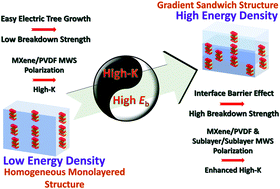An ultrahigh discharged energy density achieved in an inhomogeneous PVDF dielectric composite filled with 2D MXene nanosheets via interface engineering†
Abstract
Simultaneously improved permittivity and breakdown strength, accompanied with reduced dielectric loss and conductivity, are difficult to achieve in polymer nanocomposites with conductive fillers by blending to construct a homogeneous structure. In this work, an MXene/fluoropolymer nanocomposite with a gradient sandwich structure has been prepared by casting various polymer solutions thrice, followed by annealing. Unfunctionalized Ti3C2Tx MXene nanosheets with lower conductivity and higher Young's modulus compared to graphene nanosheets have been utilized as fillers. Polyvinylidene fluoride (PVDF) has been employed as the polymer matrix. High interface compatibility between MXene and PVDF, as well as between the adjacent two sub-layers in the sandwich composite, has been obtained due to effects of p–π conjugation, hydrogen bond and similarity compatibility, leading to enhanced interface polarization and improved permittivity. The interface barrier effect between the neighboring two sub-layers restrains electric tree growth, resulting in elevated breakdown strength. Compared with mono-layered composites and PVDF, the sandwich composite shows improved comprehensive electrical properties. It has a permittivity of ∼26 at 100 Hz, a breakdown strength of ∼350 MV m−1 and an energy density (efficiency) of ∼12.5 J cm−3 (∼64%) at breakdown strength. This work might open the way for large-scale fabrication of promising nanocomposites with a high energy storage density.



 Please wait while we load your content...
Please wait while we load your content...